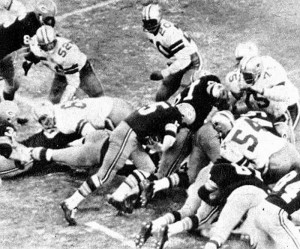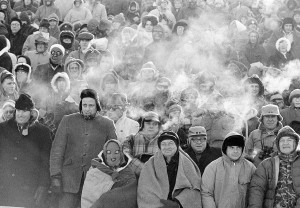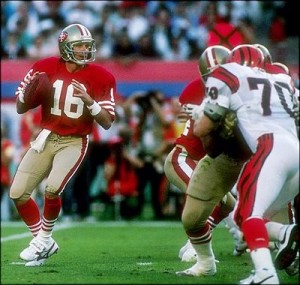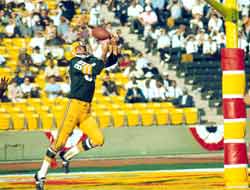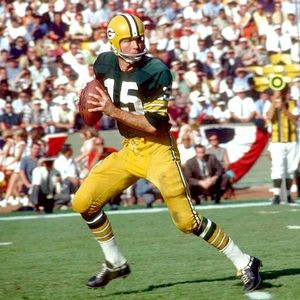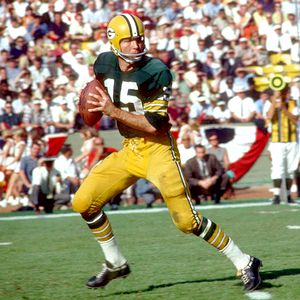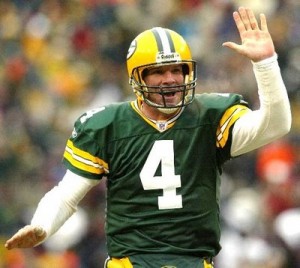NFL at 100: Top 100 Players of All-Time – 75-51 2
One of the cool parts of the NFL celebrating 100 years in 2019 is remembering the great moments and players that have helped shape the history of the game.
The NFL Network and others have developed their own All-Time teams or top 100 player lists.
Not to be out-done, we have also chosen Sports Then and Now’s top 100 players in NFL history.
We are breaking the selections into four groups of 25. You can read our players 100-76 here. We will be featuring the top 50 in two subsequent posts.
In a sport that has seen great change and evolution over 100 years, creating any comprehensive all-time list is going to be subjective and open to interpretation. You can read more about the criteria we used to select our top 100 players.
This is the second of four posts announcing the ST&N Top 100. This one includes players 75-51 (the team listed is the one they were most associated with during their career).
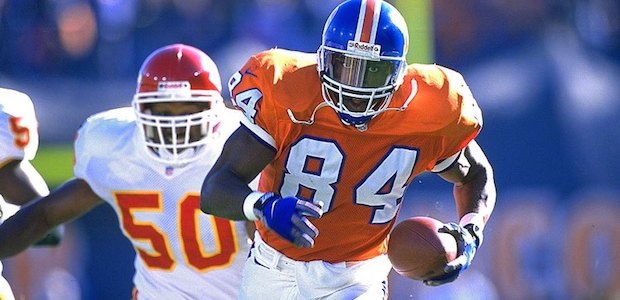
75. Shannon Sharpe – Denver Broncos – 8 Pro Bowls; 4 time 1st Team All-Pro: The most dominant tight end of his era, Sharpe was a key weapon for John Elway during the 1990s. He caught 80 or more passes three times and also had three 1,000 yard seasons. He helped the Broncos win back-to-back Super Bowls in 1997 and 1998 and then caught 67 passes to help the Baltimore Ravens win the Super Bowl following the 2000 season.
74. Ernie Nevers – Chicago Cardinals –5 time 1st Team All-Pro: A four-sport college star at Stanford, Nevers played five seasons in the NFL (1926-27 with the Duluth Eskimos and 1929-31 with the Chicago Cardinals) and was a first team All-Pro as a fullback each season. In 1929 he established an NFL record that still stands when he scored all 40 points (six touchdowns and four extra points) in a 40-6 win over the Chicago Bears. He was an inaugural inductee of the College Football Hall of Fame in 1951 and the Pro Football Hall of Fame in 1963.
73. Paul Warfield – Miami Dolphins – 8 Pro Bowls; 2 time 1st team All-Pro: One of the greatest deep-threat receivers in NFL history, Warfield averaged 20.1 yards per reception for his career. With 85 career touchdown catches out of 427 career receptions, he averaged a touchdown for every five receptions throughout his career. He helped the Cleveland Browns win the NFL Championship during his rookie season and then proved to be a key addition for the Miami Dolphins as they went to three straight Super Bowls and won consecutive titles in 1972 and 1973.
72. Randall McDaniel – Minnesota Vikings – 12 Pro Bowls; 7 time 1st team All-Pro: One of the top offensive linemen of the 1990s, McDaniel was a first-team All-Pro guard seven times and second-team twice between 1990 and 1998.
71. Randy Moss – Minnesota Vikings – 6 Pro Bowls; 4 time 1st team All-Pro: Few players have created the immediate buzz that Moss did as a rookie with the Minnesota Vikings in 1998. He caught 69 passes for 1,313 yards and a league-high 17 touchdowns as the Vikings went 15-1. He eclipsed 1,000 receiving yards 10 times during his career and had nine seasons with 10 or more touchdown receptions. In 2007 with the New England Patriots, he established an NFL record with 23 receiving touchdowns to help the Patriots finish 16-0 during the regular season.
70. Steve Largent – Seattle Seahawks – 7 Pro Bowls; 1 time 1st team All-Pro: The first Superstar of the Seattle Seahawks franchise, Largent was one of the most prolific receivers of his era. He had 70 or more catches six times in his career and eclipsed 1,000 receiving yards eight times, including twice leading the league. He had double digit touchdown receptions three times and was the first player in NFL history with 100 touchdown receptions. At the time of his retirement he was the NFL career leader in receptions, receiving yards and receiving touchdowns.
69. Jonathan Ogden – Baltimore Ravens – 11 Pro Bowls; 4 time 1st team All-Pro: A dominant left tackle, Ogden was selected to the Pro Bowl in each of the final 11 seasons of his career. He was called for only 15 holding penalties in 12 seasons.
68. Ray Nitschke – Green Bay Packers – 1 Pro Bowl; 2 time 1st team All-Pro: A key member of the Green Bay Packers five championship teams in the 1960s, Nitschke was a two-time first team All-Pro and three time second team All-Pro at middle linebacker. He had 25 interceptions and recovered 23 fumbles during his career.
Read the rest of this entry →